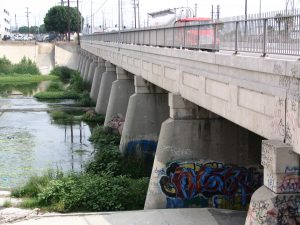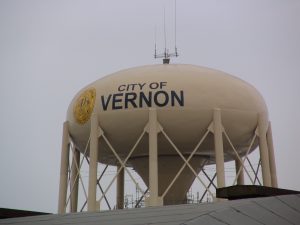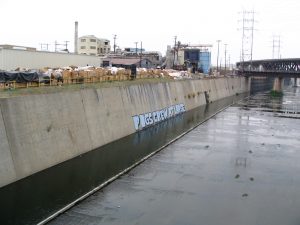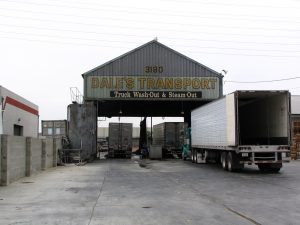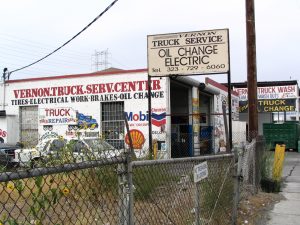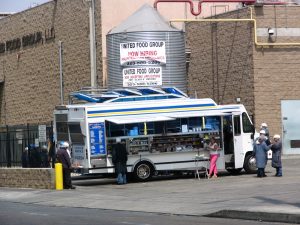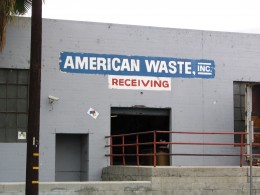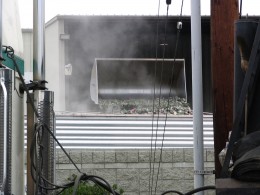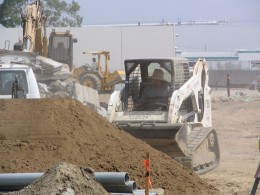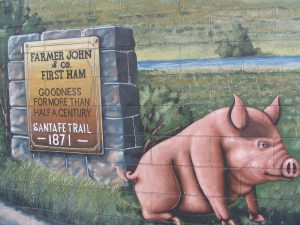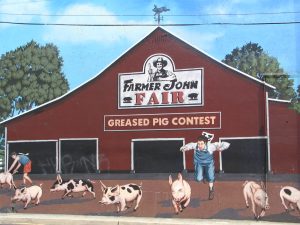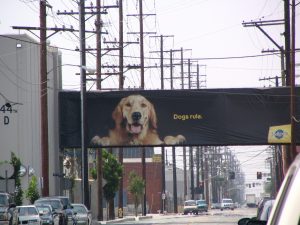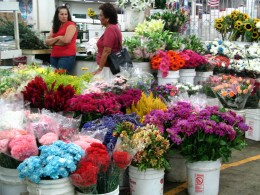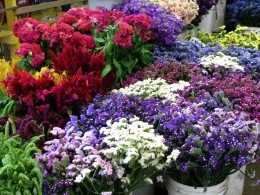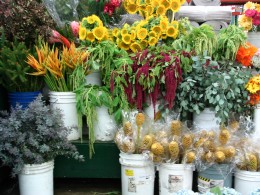So far in our travels up and down the Los Angeles River we’ve been pretty much in Los Angeles, as you might expect. We’ve nipped into the southern borders of Glendale and Burbank, but that’s pretty much it. Upstream it’s LA all the way, though it’s broken up into a lot of neighborhoods. Downstream, it’s a different story. Not far south of downtown the river takes a bend to the east, and then heads almost due south through a string of little communities until it reaches Long Beach, where the last thing it passes, in the (recently named, I’m guessing) Queensway Bay, is the magnificent but somehow sad, set-in-concrete, Queen Mary, now a hotel and entertainment destination … and recently bankrupt, according to the news. Then the river dumps its load of Ralph’s shopping carts, Thunderbird bottles, plastic Wal-Mart bags, and MacDonald’s Styrofoam clamshells into Long Beach Harbor for the dolphins, sea lions, and California gray whales to enjoy. We can hardly wait to see this spectacle, but it’s many days away.
Los Angeles is a strangely shaped city. There’s the Valley, incorporated in a series of big gulps from 1915 to as late as 1965. Only a few communities fought off the juggernaut, from Burbank and Glendale, to Beverly Hills and Culver City (both totally surrounded by LA), to Santa Monica. Then there is the original LA, the basin, roughly from the river to the sea—plus East LA, which nobody pays much attention to, at least in city government. Then from the south side of LAX, El Segundo, it’s pretty much a straight line over to Watts, then another more-or-less straight line north to the downtown area. East and south of those lines is a checkerboard of smaller towns, once separated from each other and connected by the much loved, much missed old Red Line trains, now distinguishable only when you see a sign saying ENTERING BELL GARDENS.
I say “pretty much” a straight border, because there’s an anomaly. A narrow strip of land—and by narrow, I mean less than half a mile wide in some places—zigs and zags a few times, an umbilicus of LA that connects the city to what they’d like you to refer to by the rather grand name of WORLDPORT LA, but most people call the Port of Los Angeles. Except for the real old-timers, who refer to it as San Pedro.
San Pedro was an independent town until 1909, when LA Times publisher Harrison Gray Otis and Senator Stephen M. White—robber barons extraordinaire—persuaded Congress to let LA annex it, dredge what had been little but mudflats, and build a breakwater. Result: The Port of LA is the busiest container port in the US, and the 8th in the world. Why they didn’t manage to annex Long Beach as well, and have maybe the world’s biggest port, I have no idea. Maybe Long Beachers had more political clout than San Pedrans. But there it sits to this day, dangling like a swelling on the end of a vermiform appendix, a textbook case of gerrymandering. California is full of fascinating stories like that. And that’s why we won’t be seeing LA again on this trip down the river named after the city, but will end our trip in Long Beach, instead. So ends today’s California history lesson.
Now, back to Vernon …
Vernon is an odd little town. Like the City of Industry to the east, it exists to provide a place for businesses to thrive with very low taxes and cheap utilities, and thus it is filled with warehouses and such. About 50,000 people work there, but almost no one lives there. It has a population of 91. That’s right, 91. Most of those are Hispanic. (The Asian population is 1.1%. That means 1.001 Asians. His name is Sammy Chang, who promises to lay off the dumplings and plum sauce until he loses enough weight to be 1.000 Asian. Just kidding.) At 5 square miles, that makes the population density of Vernon 18.2 people per square mile. I think Death Valley is denser than that. Our proud civic motto, on the city seal: Exclusively Industrial!
You’d think nothing much would have happened since 1847, when the Battle of La Mesa was fought there, the last Alta California skirmish in the Mexican American War, other than the odd warehouse fire or train derailment, but you’d be wrong. Vernon has recently been the site of some serious hanky-panky. One Albert Robles (currently serving 10 years as a guest of the state for stealing everything that wasn’t nailed down in the neighboring city of South Gate) and his gang of Mexican Mafia attempted to steal an election. With so few voters, it looked like easy pickings. You just move a dozen of your friends into town, register them, run three for the city council, and intimidate some other voters. Mr. Robles sounds like a fascinating character. He was elected mayor of South Gate at age 26 and started on his looting spree. He’ll still be young when he gets out of the slammer, with time for a lot more mischief.
In case you feel sorry for the incumbents Robles was trying to unseat, consider the fact that the current mayor of Vernon, Leonis Malburg, has held his post for 50 years—I’ll bet that’s a record; African dictators and Haitian Presidents-For-Life would envy that run—and apparently doesn’t even live in Vernon, but in Hancock Park, the neighborhood of choice for wealthy blacks and Latinos. His grandfather was mayor, too. Leonis the Younger is also under investigation for voter fraud, and the city administrator, Bruce Malkenhorst, is accused of stealing $60,000 in city money. His salary from the city had been $600,000 per year, which, to me, is theft right there. After I learned all this stuff I decided to keep my hand firmly on my wallet when we walked through this nest of crooks, and to walk as fast as I can.
If you think I’ve been stalling though all this background material about Los Angeles and Vernon … you’re right. I’m not eager to get into it. Vernon is much more fun to write about than to walk through. In fact, I’d say it was my least favorite day walking the river. But I’ll fall back on my motto for days like this, “We’re doing it so you don’t have to!” and get on with it …
If the previous day’s walk was about trains and warehouses, today’s was about trucks and warehouses. I like trains. I don’t like trucks. Trucks are smelly and loud, and twice I had my hat blown off by a big semi blasting past me. By the end of the walk I felt covered in grime, gritty, and slightly sick from the diesel fumes. Yeah, I know, nobody comes to Los Angeles for the air, but this was way beyond our usual smog. My ears were ringing, too. All in all, I was in a foul mood, and happy to get out of Vernon. Next time we will have to visit it again, alas, but only for a short time. Next time, there’s a chance that we will walk through no less than four different towns.
Vernon is colorless and virtually plantless and completely joyless. And here’s an irony. We have walked through many beautiful places in LA only to find there are no sidewalks for blocks at a time. Whoever planned these places never thought anybody would walk there. Vernon, where nobody would want to walk, has sidewalks on both sides of every street. We did see a few people on foot, but they all seemed to be walking just from one warehouse to another. At lunchtime, hordes of lunchwagons descend on Vernon from some more hospitable clime, and workers come out to buy a couple tacos and a bottle of Jarritos hibiscus-flavored soda pop, but other than that and the ever-present trucks thundering by, there is very little sign of the many thousands of people who work there.
I’m looking at Lee’s pictures—and naturally she took a lot, she always does, of the river, of warehouses, of whatever catches her eye—trying to think of something interesting to say about Vernon, and I’m at a total loss until we come to Farmer John, near the end of our walk. Farmer John takes up a very large block and several others in the neighborhood. He’s a major employer. Farmer John is all about pigs. Their walls are covered with very large, very long murals showing the sort of bucolic farm setting I suppose they want you to picture when eating a Farmer John sausage. Tow-headed hicks in a greased pig contest, happy porkers grazing on green grass. Stuff like that. In reality, of course, all those oinkers are raised in dark buildings oozing pigshit, in pens not big enough to turn around in. We had passed a lot of meat distributing plants, and they mostly seemed to deal in animals that were already killed and arrived frozen, or as dressed sides ready to be cut into smaller stuff. I assumed that Farmer John was the same way, because the plant doesn’t stink. Stockyards stink, as anyone who has traveled down I-5 can attest. I’d assumed abattoirs would stink, too, but this one didn’t, and it was definitely a slaughterhouse. We saw four trucks pass within fifteen minutes, with ventilation holes where we could see the hogs inside. They were double-decker trucks, and I wondered if the shit from the upper level fell down on the ones in the lower berths. But the trucks didn’t stink, either. Have they found a way to raise pigs that don’t shit? It wouldn’t surprise me, with genetic engineering and factory farming and all.
I am a long, long way from being a PETAmaniac, but I’ll admit to you that modern animal “husbandry” methods make me a little queasy. And I normally like touring factories, but if one was offered at Farmer John, I’d give it a pass. I’d rather not know. I like animals, and I like meat; does that make me a hypocrite? If so, so be it. Just watching those truckloads of ham on the hoof in what must surely be their last minutes of consciousness made me sad. But it didn’t put me off my bacon this morning.
EXTRA BONUS MATERIAL!!!
The Flower District
Vernon being so colorless and, aside from the Farmer John’s murals, Lee’s pictures reflecting that drabness, I thought it was time to treat you with another outtake on our trek toward the Queen Mary, and what better than the Flower District?
Words pretty much fail me in the Flower District. It’s one of those things you have to see to appreciate, the riot of color and smells. This is where all the florists come, early in the morning, to pick up the stuff they’ll work into arrangements during the day for funerals, weddings, Quinceañeras, and get-well hospital bouquets. But it is also open to the public, shortly after the dealers depart, for a reasonable $1 admission fee, and you can buy there, too. It is dominated by two huge warehouses that are simply jammed with cut flowers. Nothing fancy here, just bucket after bucket of color. Areas of the floor are marked off for the different vendors, who are mostly Hispanic and Japanese. Some specialize in daisies, some in roses, some carry just about everything. We had been here once before, and were a little disappointed in that the stock seemed to have been picked over and somewhat diminished from what we’d been led to expect. But this day, a Saturday fairly early, it was amazing. We wandered around in the cool, scented air, and every corner we turned presented a fresh vista of color.
There are little shops off to the side that sell more elaborate stuff, including at least two that specialize in orchids. There must be 50 varieties, hundreds of pots of each sort, and the prices are cheap. You can save a little money here on roses, a little more on daisies, but you can really make out with orchids, up to 60 or 70% off what you’d pay at a florist.
The streets for several blocks in all directions are also lined with flower and plant wholesalers. You can get everything you need for a garden, or just a vase full of color. Lee took a lot of pictures. Enjoy!
July 20, 2007
© 2007 by John Varley; all rights reserved

